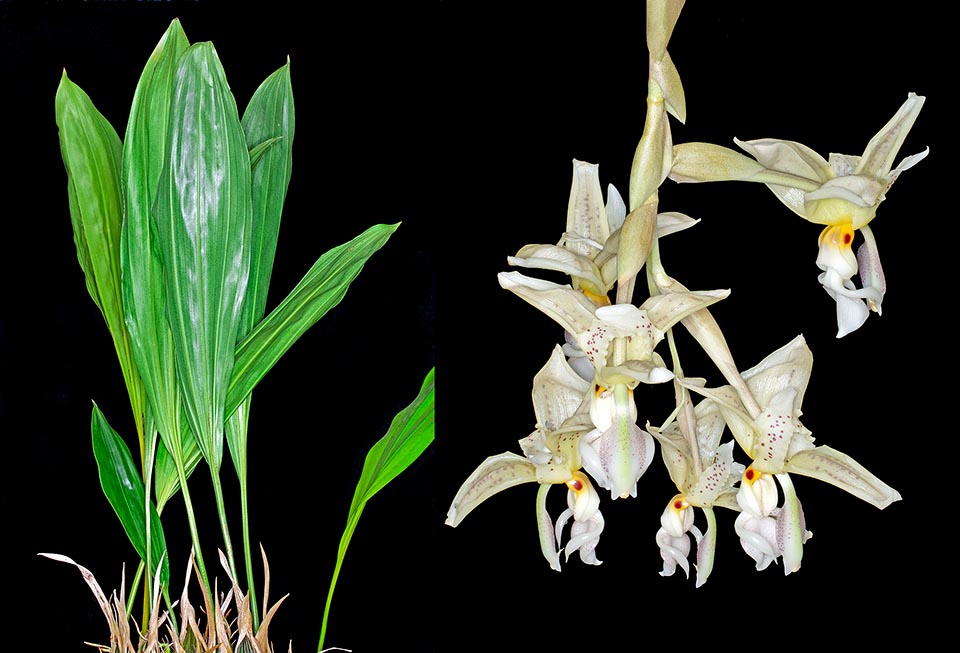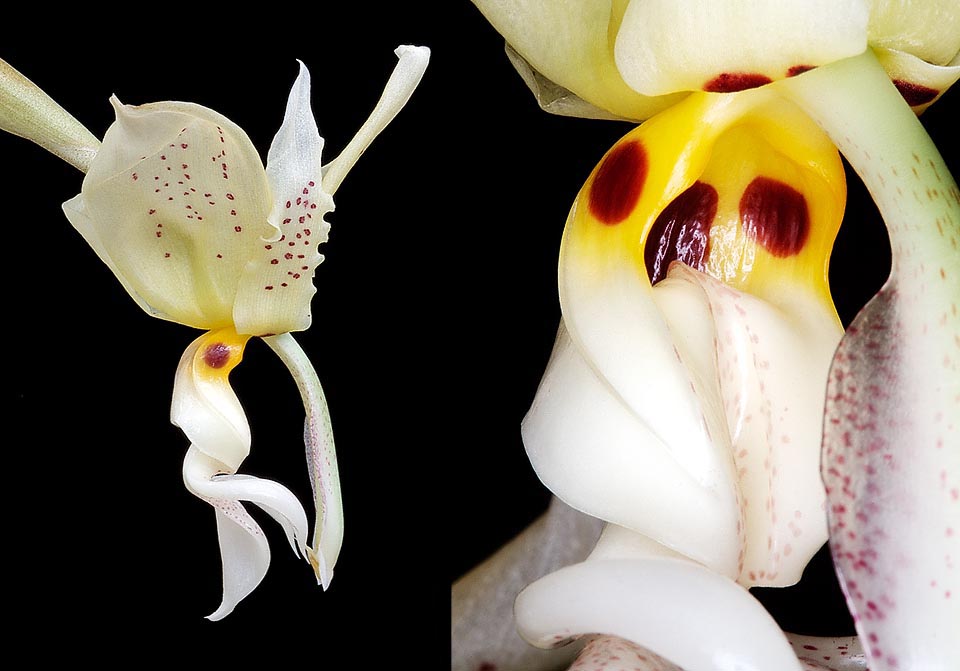Family : Orchidaceae

Text © Pietro Puccio

English translation by Mario Beltramini
The species is native to Belize, Guatemala, Honduras, Mexico (Chiapas, Oaxaca and Veracruz) and Nicaragua where it grows on the trees of the humid forests between 200 and 1400 m of altitude.
The genus is dedicated to Philip Henry Stanhope (1781-1855) who was president of the Royal Medico-Botanical Society of London; the specific name is honoured to the English collector of orchids Sigismond Rucker (1810-1975).
The Stanhopea ruckeri Lindl. (1843) is an epiphytic species with ovoid pseudobulbs, slightly laterally compressed, grooved, 4-7 cm long and about 4 cm broad, carrying only one leaf at the apex. The petiole is thin, grooved, about 5 cm long, the lamina, elliptic to obovate-elliptic with acute apex, plicate, is 20-55 cm long and 8-15 cm broad.

Stanhopea ruckeri is a Central American epiphyte with grooved ovoid pseudobulbs, 4-7 cm long and about 4 cm broad, bearing only one 20-55 cm leaf at the apex. On the right a portrait of the hanging lateral inflorescence, 20-35 cm long. It can bear 3-10 showy flowers of 10-14 cm of diametre emitting a light fragrance © Giuseppe Mazza
Racemose lateral inflorescence, on a peduncle covered by membranous sheaths, hanging, 20-35 cm long, bearing 3-10 showy flowers emitting a slight fragrance, of 10-14 cm of diametre, with greenish or cream white brown reddish dotted sepals and petals and white cream labellum, excepting the base of orange yellow colour with brown red spots; a completely white form does also exist.
Oblong-ovate sepals with obtuse or acute apex, concave, 5-6,5 cm long and 2,5-4,5 clm broad, elliptic-lanceolate petals with acute to acuminate apex and wavy-wrinkle margins, 4,5-5,5 cm long and 1,5-2,4 cm broad. About 5 cm long and 3 cm broad labellum, tripartite, formed by a short saccate base, called hypochil, an intermediate part, mesochile, with two falcate horn-shaped protuberances, pointed, 3-3,5 cm long, and the final part, the epichile, ovate with acute apex; the column is arched, 4-5 cm long, equipped with two wings.
It reproduces by seed, in vitro, and by division upon the vegetative restart, with each section provided with at least 4-5 pseudobulbs.

In this odd combination of two details the imaginative image appears to us of a tightrope dancer observed by an owl. Surely, they are flowers that lead us to dream and it is good to know that it is not an endangered species. It is often found in botanical gardens and in the lovers collections due to its rapid growth and easy cultivation © G. Mazza
Species easy to cultivate and with rapid growth, floriferous, requires intermediate to warm temperatures and a very luminous position, even some hours of direct sun in the morning, high humidity, 65-75% and constant ventilation. The waterings must be regular and abundant, but without stagnation, during the growing time, more spaced during the vegetative stasis, paying attention to never allow the substratum to dry up completely. It is usually cultivated in suspended baskets provided with wide openings in order to allow the inflorescences to get out freely, duly covered to hold the substratum with compressed sphagnum sheets or coconut fibre. The compound may be formed by fragments of bark and charcoal or of medium sliced coconut fibre and sphagnum. Fertilizations every two weeks from spring to autumn, monthly in winter, with a balanced hydrosoluble product, with microelements, at 1/4 the dose shown on the package. It is to be left not distubed till when the substratum does not show marks of deterioration to allow the plant to tiller and form big tufts with showy bloomings.
The species is reported into the appendix II of the CITES (species for which the trade is ruled at international level).
Synonyms: Stanhopea inodora Lodd. ex Lindl. (1845); Stanhopea ruckeri var. speciosa Lem. (1854).
